
Manuel Kulukundis (1898-1988) and Minas Rethymnis were cousins, both from the island of Kasos near Karpathos in the southern Dodecanese islands, and had grown up together on Kasos and gone to school together. Their fathers suggested that they should move to London after the end of World War I and try their luck in the epicentre of world shipping. After stepping ashore at Dover from the Calais ferry in March 1920, they shared an apartment in Southampton Row near Russell Square in Bloomsbury and set up their firm as Rethymnis & Kulukundis with a shared capital of £150 on 21st July 1921 at 15 Great St. Helens off St. Mary Axe. They became so famous in the world of shipping as shipbrokers, ship’s agents and shipowners that they were known throughout the world of shipping as simply ‘R & K’ of London, with Rethymnis & Kulukundis Ltd. incorporated as a limited company on 22nd March 1922.
They had both grown up with fathers and grandfathers who owned and commanded tramps sailing the world for charters carrying many types of cargo, trading mainly in the Mediterranean and Black Sea. Capt. Elias Kulukundis (1858-1926) had sailed from Kasos in 1898 on a part owned handsome three masted 900 tonne barque named Anastasia with a cargo of tiles for Russia, but was forced to put into Syros in the Cyclades for refuge as there was bitter fighting in the Aegean between Crete and Turkey. Eleni Kulukundis, his wife and daughter of Manuel Mavroleon from the Peloponnese region of Greece, and two of their sons were also on board during this voyage that was cut short by war. They were to have six sons in George Elias, Basil, Nicholas, Manuel born in November 1898, John and Michael.
While Capt. Elias Kulukundis was at sea commanding his ship, his son Manuel Kulukundis was able to look through his father’s papers at home including the Lloyd’s of London circulars and charter parties and became very familiar at an early age in how to run a shipping business. School holidays were spent on his father’s ships sailing to many ports including Constantinople and up the Danube and in the Black Sea. He had a great love of ships and his ambition was to sail on tramps at first and then become a shipowner.
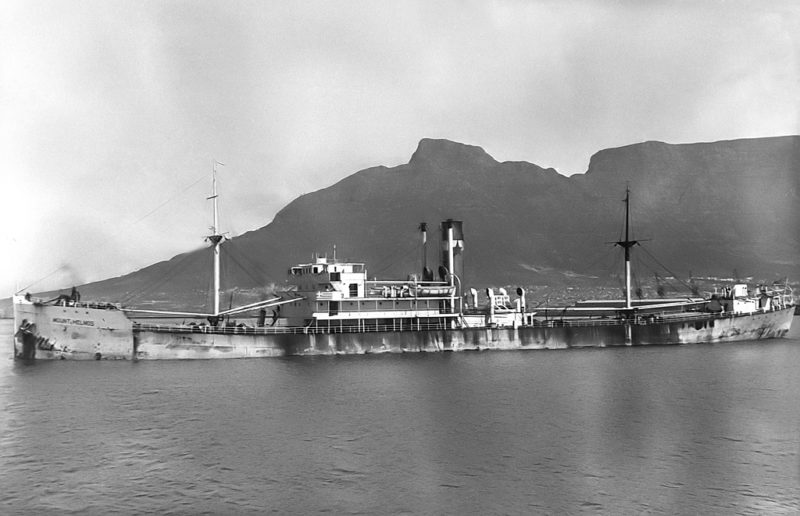
Capt. Elias Kulukundis owned a tramp called Lily in 1917, which loaded a cargo in Egypt but was torpedoed off Port Said, fortunately all of the crew were rescued by a ship owned by Michael Lemos, a friend who had previously sailed as Mate on one of the Kulukundis tramps. The history of the Lemos clan from the small island of Oinoussai off the eastern shore of Chios has been given in an earlier article in this magazine. Manuel Kulukundis served in the Greek Navy during World War I and kept in touch with his cousin and school friend of Minas Rethymnis.
Capt. Nicholas B. Rethymnis (1886-1981), elder brother of Minas, also helped in the setting up of R & K in 1921 and had an eventful voyage through the Mediterranean during World War I as Master of the tramp Chrysopolis, owned by a Rethymnis-Yannaghas-Pneumaticos partnership on Kasos. She was loaded with a cargo of cotton seeds from Alexandria for Hull, but had the misfortune to be stopped on two occasions by the same Austro-Hungarian submarine, killing some of the crew and wounding her Master, but other vessels appeared on the scene and interfered with the capture of the tramp on both occasions, which was able to make good its escape.
It was possible in the inter-war years for a shipping company to prosper with a very low set-up capital given hard work and a flair for chartering on the part of the owners. This was the case with ‘R & K’, as their first transaction as shipbrokers was in August 1921 when they purchased one of the German prize ships that Lord Inchcape had offered for sale. This was Rooke of 3,391 grt built in 1908 by Chantiers Navegacion Anversoise of Hoboken as Slawentzitz with a triple expansion steam engine supplied by the North East Marine Engineering Co. Ltd. of Newcastle. She had been captured by a British cruiser in 1914, and the partners paid £17,000 for her and sold her at a profit to a Greek owner. A total of eight ships were purchased from Lord Inchcape by R & K and sold on at a profit.

This was also the case with two purchases in 1922, the German steamer Lindenfels of 5,699 grt and built in 1906 that had been seized by Britain off Aden in 1914 and traded during World War I as Kingsmere, and was purchased and sold in 1922 to J. A. Cosmetto of Piraeus and renamed Agios Ioannis, transferring in 1938 to the Atlanticos Steamship Co. Ltd. of Syros, a ‘R & K’ shipping company. Also in 1922, the war standard ship War Cavalry of 5,600 grt, built in 1919 at Vancouver, was purchased and sold at a profit and renamed Atlanticos to a Greek shipowner. The East Asiatic Company (EAC) of Denmark steamer Magdala of 3,490 grt and built in 1914 was purchased in 1923 and sold on to a member of the Rethymnis family on Syros and renamed Chelatros.
Manuel Kulukundis was appointed London agent in 1923 for the Union of Greek shipowners, and with these successes, felt able to ask his brothers George and Nicholas Kulukundis, both Master Mariners, to come to London to command their ships, while two more brothers, John and Michael Kulukundis arrived in London in 1927/28 making five ‘K’ brothers, plus another cousin Basil Mavroleon (1900-1978), who was taken on as an office boy and messenger at 25 shillings per week, soon learnt the art of chartering and practically lived in the Baltic Exchange. Manuel also married in Paris in 1929 Calliope Hadjilias, daughter of another shipowner of Kasos and Syros, and they had two sons, both of which later worked in shipping connected with R & K.
An opportunity arose between 1932 and 1934 for R & K to buy and sell twenty five good quality standard cargo ships built at the end of World War I from member companies of the failed Royal Mail Lines, which had a financial crash after its Chairman had been imprisoned in 1931 for grossly overstating the profit potential of a financial prospectus. Ships of Elder Dempster Line, Union-Castle Line, and the Pacific Steam Navigation Co. Ltd. (PSNC) that were sold off included Bata, Bompata, Bathurst, Barracoo, Badagry, Boutry, Ballena, Bothwell, Fantee, Jekri, Jebba, New Mexico, New Georgia, Matadi, Roquelle, Bratton Castle, Bampton Castle, Banbury Castle and Rosyth Castle, the latter ship bought and sold in 1936. The steamer Ballena of 5,210 grt and built on the Tyne in 1920 by the William Dobson yard for the Pacific Steam Navigation Co. Ltd. (PSNC) was bought for £6,000 and was sold on at a profit four years later to Hamburg Sűd for £55,000.
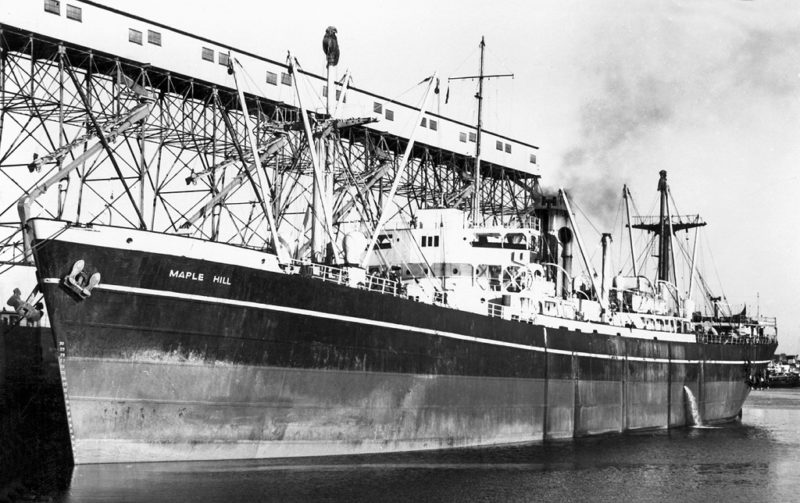
A steamer of 3,201 grt, built by the Doxford yard in Sunderland as Lord Byron for M. Embiricos and renamed Maid of Sparta in 1928, was purchased in 1931 and renamed Nicolaos G. Kulukundis. A year later, Manuel Kulukundis purchased the steamer M. Poutous built in 1900 and sold her for scrap, receiving £2,100 for her. He immediately in the same month used this money to purchase the steamer Maindy Grange of 4,810 grt built in 1914 for Sir David Llewellyn of Cardiff and sold her at a profit to a Greek shipowner, who renamed her Mount Pindus and manned her with the same crew from M. Poutous.
The Sir William Reardon Smith of Cardiff steamer Great City of 5,523 grt and built by the Ropner yard at Stockton in 1914 was purchased in 1936 for £14,000 for a group of clients of the Lemos clan, who came to Manuel Kulukundis with their cousins and friends as they did not have the resources of their own to buy a ship. Manuel organised them into a group to own the steamer Great City, which was sold a few years later to German owners for over £50,000. R & K acted as ship’s agents for 30 Greek owned ships in 1927 and 75 Greek owned ships in 1939, with their agency commission alone at well over £30,000 per annum.
The purchase and sale transactions in the inter-war years numbered in the hundreds, in equal numbers of sale and purchase agreements. The main R & K shipowning companies for tramps owned in Greece were the Kulukundis Shipping Co. S. A. (formed in 1938), the Atlanticos Steamship Co. S. A. (formed in 1938), and the Kassos Steam Navigation Co. S. A. (formed in 1927). Many of these Greek owned ships were given a ‘Mount’ prefix to their names e.g. Mount Aetna, Mount Atlas, Mount Athos, Mount Cynthos, Mount Dirfys, Mount Helmos, Mount Helikon, Mount Hymettus, Mount Ida, Mount Ithome, Mount Kassion, Mount Kitheron, Mount Lycabettus, Mount Myrto, Mount Mycale, Mount Olympus, Mount Ossa, Mount Othrys, Mount Pera, Mount Pelion, Mount Parnassus, Mount Parnes, Mount Pentelikon, Mount Prionas, Mount Pindus, Mount Rhodope and Mount Taurus.
During 1933/34 with rising freight rates, the cousins decided that the time was right to own tramps of their own under the Red Duster. The Tower Steamship Co. Ltd. was set up in November 1933 to briefly own four ‘WAR’ standard types renamed as Tower Abbey, Tower Bridge, Tower Crown and Tower Ensign. Some of the purchases were entirely speculative e.g. the Elder Dempster turbine powered cargo liner Bompata built in 1923 was purchased for only £8,500 in July 1934 and re-engined at a cost of £12,000 with triple expansion steam engines, renamed Tower Dale and briefly traded before being sold for £36,500, giving a capital profit of £16,000. The two year old steamer Roxburgh of the Sutherland Steamship Co. Ltd. of Newcastle was purchased in 1937 for the Tower Steamship Co. renamed Tower Field.
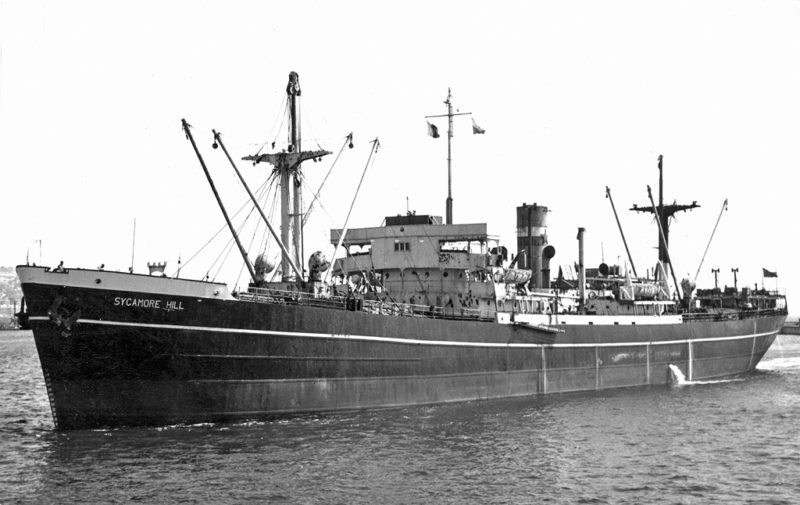
The partners then set up two companies named after English Counties in the Sussex Steamship Co. Ltd. and the Surrey Steamship Co. Ltd. in 1934. They purchased the former old tramp Cardigan built in 1917 from French Line as Pensylvanie, renamed Bury Hill, as well as the Glentworth built on the Tyne in 1920 for R. S. Dalgleish Ltd. of Newcastle at low cost and renamed Box Hill. Further ‘County’ companies were set up in the Middlesex Steamship Co. Ltd. to own the ‘WAR’ standard Comeric purchased from Bank Line in 1935 and renamed Hampton Hill, the Doxford built Peebles from the Sutherland Steamship Co. Ltd. renamed Mill Hill, and African Prince from Rio-Cape Line with Prince Line Ltd. as managers renamed Pentridge Hill, and Clan Macvicar from the Clan Line Steamers Ltd. and renamed Dover Hill. Canadian Constructor built in 1922 was purchased in 1939 and renamed Argos Hill, and the Newcastle tramp David Dawson built in 1919 as War Burman was also purchased in 1939 and renamed Brockley Hill. The converted tanker Inverleith was owned for a year during 1936/37.
The Counties Ship Management Co. Ltd. was set up in 1934 to give cohesion to these many single ship companies. Loans of £2,000 from London shipbrokers and owners Lambert Brothers, and £5,000 from William Deacons Bank, allowed the first down payments on a series of ships to be made. The ‘Counties’ ships adopted a yellow funnel with a black top with a red ‘C’ inside a thin red ring, and flew a swallow tail pennant of white and red with the same red ‘C’ inside a thin red ring. An initiative by Manuel Kulukundis led to the setting up of the Greek Shipping Co-operation Committee in mid 1935 to restore charter rates to tolerable levels on the important Plate grain trade to Europe, and freight rates generally had improved by 1936.

WORLD WAR II
Pentridge Hill was immediately sold on the outbreak of war on 3rd September 1939 to the Board of Trade and renamed Botlea and managed by Sir William Reardon Smith & Company of Cardiff until she was scuttled with a cargo of gas shells in the Atlantic in December 1945. On the outbreak of war, fifteen tramps were chartered to the British Government Ministry of Supply, while fifteen were also chartered to the Swiss Government to carry grain and Red Cross supplies to Allied prisoners of war. All of the R & K tramps were later requisitioned by the British Government in October 1940, at the same time that Manuel Kulukundis and his brothers George, Nicholas and Michael transferred to New York to continue trading, while John Kulukundis and Basil Mavroleon remained in the U.K. to run their ships under M.O.W.T. control. Four of these were then lost to enemy action:-
Box Hill (5,677 grt) – mined and sunk off the Humber on 31st December 1940 while on a voyage from St. John (NB) and Halifax (NS) to Hull with wheat. 20 lives lost.
Mill Hill (4,318 grt) – torpedoed and sunk on 30th August 1940 while on a voyage from Boston to the Tees with steel and pig iron. All of her 34 crew were lost.
Brockley Hill (5,287 grt) – torpedoed and sunk on 24th June 1941 in mid-Atlantic while on a voyage from Montreal to London with 7,000 tonnes of wheat.
Dover Hill (5,815 grt) – bombed and damaged at Mishukov Anchorage in Kola Inlet on 4th April 1943, and then taken over by the Ministry of War Transport with J. & J. Denholm as managers. She returned to the U.K. and was sunk as a blockship at Normandy on 9th June 1944.

Five 10,000 dwt replacements were ordered from William Hamilton & Co. Ltd. at Port Glasgow, three were given ‘Hill’ names of Kingston Hill, Lulworth Hill and Primrose Hill, while two were named after Michael E. Kulukundis and his wife as Michael E and Marietta E. Four motor tramps were then completed for Counties management by Doxford during 1940/42 as Putney Hill, Coombe Hill, Tower Hill and Tower Grange. Two more steam tramps from the Bartram yard at Sunderland completed the private building programme as Richmond Hill and Pentridge Hill. Seven of these were sunk by the enemy:-
Michael E. (7,628 grt) – torpedoed and sunk in mid Atlantic on 2nd June 1941 while on a voyage from Belfast to Halifax (NS). 4 lives lost.
Kingston Hill (7,268 grt) – torpedoed and sunk on 7th June 1941 midway between Dakar and Pernambuco while on a voyage from Cardiff and Glasgow to Table Bay and Alexandria with coal. 14 lives lost.
Putney Hill (5,216 grt) – torpedoed and sunk on 26th June 1943 NE of the Bahamas while on a voyage from Haifa to Table Bay and New York in ballast. 3 lives lost.
Primrose Hill (7,628 grt) – torpedoed and sunk on 29th October 1942 near Cape Verde Islands while on a voyage from Glasgow to Takoradi and Apapa with general and coal. She had been equipped as a ‘CAM’ ship with a fighter plane. 3 lives lost.
Tower Grange (5,226 grt) – torpedoed and sunk on 11th November 1942 NE of Guiana while on a voyage from Calcutta and Table Bay to Trinidad and U. K. with ore and general. 6 lives lost.
Marietta E. (7,628 grt) – torpedoed and sunk on 4th March 1943 130 miles south of Durban while on a voyage from New York to Durban, Aden and Alexandria with Government stores. 5 lives lost.
Lulworth Hill (7,628 grt) – torpedoed and sunk on 19th March 1943 east of St. Helena while on a voyage from Mauritius to Freetown and the U.K. with sugar and rum. 36 lives lost.
Michael E. had been completed in May 1941 at Port Glasgow and was the first of the ‘CAM’ ships fitted with a catapult or steel gantry runway of 85 feet in length with a trolley, which was blasted along with a Hurricane fighter by cordite rockets. She had sailed on her maiden voyage from Belfast with a Fleet Air Arm pilot, two other officers and nine ground crew onboard, but after dispersing from convoy OB326 in mid Atlantic a torpedo explosion did immense damage to her with numerous injuries amongst the crew. Two crew and two gunners died, one of these dying onboard the rescue vessel after being pulled through a hole on deck by his arms as both his legs were broken. In great pain from these and other injuries, he pulled himself into a lifeboat, helping the officer in charge of the boat, but unfortunately he died on the operating table.
Lulworth Hill almost escaped the torpedoes of the Italian submarine Da Vinci in a long chase to east of St. Helena after an abortive attack at night by her Italian commander helped by a German officer on secondment. Lulworth Hill fled at high speed zig-zagging and altering course to shake off her assailant, but to no avail as Da Vinci caught up with her and torpedoed her. Twenty five men died in the explosion with only 14 men escaping on a liferaft to survive an astonishing story of endurance. The raft drifted in the northerly current for 50 days but one by one the brave survivors gave up their personal struggle against thirst, hunger and the elements. Two only were left, a carpenter and a seaman, when a destroyer found them 400 miles south of Liberia. Their families had been informed of their loss some 21 days before their rescue.
Empire Tower was torpedoed and sunk on 5th March 1943 north west of Lisbon in convoy XK2 while carrying 6,532 tons of iron ore from Huelva to the Tees with the loss of 34 crew and four gunners, with only four crew and two gunners surviving as she sank quickly due to the weight of her cargo. She was the former Tower Field, which had been damaged by bombing in the Thames Estuary on 10th May 1941 while on a voyage to the Tyne in ballast, and then had been aground at the entrance to Workington while carrying iron ore on 19th October 1941 and was awash with hull fractures but was refloated and repaired. Argos Hill was badly damaged in an air raid on 4th July 1940 in outward convoy OA 178, but was repaired and remained in service until destroyed by fire on 7th August 1945. At the end of the war, the Counties Ship Management Co. Ltd. had lost 13 ships and 163 brave officers and crew .
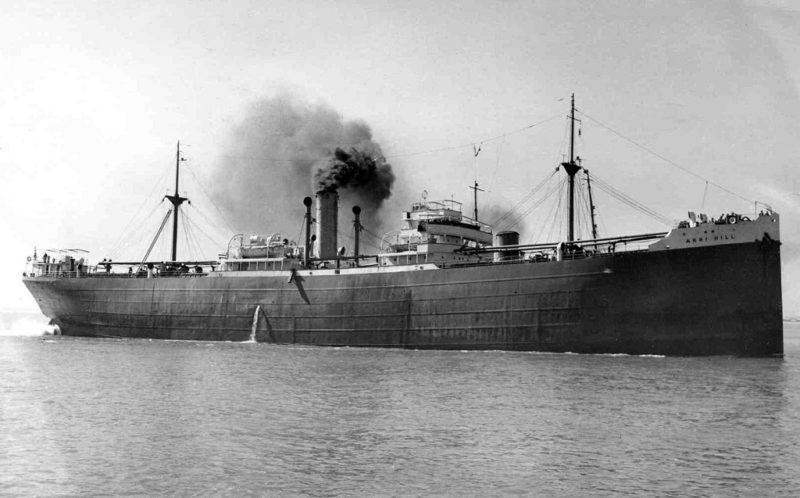
POST-WAR TRADING
Four tramps only were handed back to the Kulukundis brothers from requisition at the end of the war, but with the compensation money and bank loans a big fleet of four dozen standard war built tramps of 10,000 dwt were purchased for worldwide trading under the Red Duster between 1946 and 1950. These comprised 34 Canadian built ‘Fort’ and ‘Park’ types, eight British built ‘Empire’ types, and six American built Liberty ships. All four dozen dry cargo ships were given names with a suffix of ‘Hill’, except one.
The ‘Fort’ and ‘Park’ types were renamed as Akti Hill, Alendi Hill, Amersham Hill, Andover Hill, Beech Hill, Bembridge Hill, Cedar Hill, Denmark Hill, East Hill, Elm Hill, Fir Hill, Fry Hill, Harrow Hill, Haverton Hill, Malden Hill, Maple Hill, Marina Hill, Mavis Hill, Mulberry Hill, Muswell Hill, Notting Hill, Oak Hill, Pine Hill, Poplar Hill, Streatham Hill, Sudbury Hill, Sycamore Hill, Tulse Hill, Wembley Hill, West Hill, Winter Hill, Woldingham Hill and Wynchwood Hill. Fort Astoria was the exception and was purchased by Counties Ship Management Co. Ltd. in 1946 and renamed Yarmouth County and was traded for two years until sold off to Panamanian owners. She was registered under Acadia Overseas Freighters Ltd. of Halifax, one of five companies that R & K used to register the Canadian built ships, the others being Acadia Overseas Freighters Halifax Ltd., Falaise Steamship Co. Ltd., Halifax Overseas Freighters Ltd. and Nova Scotia Marine Enterprise Co. Ltd.
The ‘Empire’ types were renamed as Argos Hill, Brockley Hill, Charmouth Hill, Crowborough Hill, Dover Hill, Lulworth Hill, Putney Hill and Tower Grange, while the ‘Liberty’ types were renamed as Barn Hill, Bisham Hill, Mill Hill, Porlock Hill, Primrose Hill and Stamford Hill. The ‘Empire’ and ‘Liberty’ types were all sold off in 1951/52, as the Canadian built ‘Fort’ and ‘Park’ types were preferred and some were to give long service to the partners until 1967/68.

The Kulukundis, Rethymnis and Mavroleon families had owned 60% of the share capital of Counties Ship Management Co. Ltd. until the last of the war built tramps, Denmark Hill, was sold off for breaking up in 1968.
One last British owned dry cargo ship in the fleet was the five hold motor vessel Clarkspey of 10,100 dwt completed in 1960 by the Lithgows yard on the Clyde for H. Clarkson Ltd. She was on charter to Port Line as Port Campbell from 1961 to 1966, when she was purchased by R & K and renamed Kings Reach. She was sold in 1969 and the Counties Ship Management Co. Ltd. was then wound up.
In 1947, the motor tramp Westmoor of 4,359 grt and built by Doxford in 1924 for Walter Runciman & Co. Ltd. of Newcastle was bought and renamed Akri Hill under the British flag. Some voyage examples of these owned ships are now given:-
Wynchwood Hill dry docked at Piraeus in July 1954 for repairs and survey, and then sailed to Kherson in the Black Sea to load coal and railway lines for Buenos Aires. She topped up at Odessa where security was tight with armed guards posted at the gangway. Whilst negotiating the narrow Bosphorus, the tramp was swept along by the powerful currents and the engines had to be reversed to correct her. She bunkered at Dakar and then spent September and October in Argentina discharging the coal and loading grain for Rotterdam. She was then chartered to load general cargo at Bremen and Hamburg for China, and arrived in Whampoa in February 1955 and discharged, and then sailed to the North China port of Dairen to load soya beans. Dairen had been occupied by the Russians for some years and many of the street signs were still in their language. While loading was underway, large parades of both Russian and Chinese soldiers could be seen with Chinese girl soldiers wearing red ribbons at the end of their long plaits. The soya beans were discharged at Rotterdam and she then sailed to load at Hamburg on her next charter.
Marina Hill had almost been continuously employed since 1950 in carrying coal from American eastern seaboard ports such as Newport News and Baltimore to Europe. On one voyage she sailed from Alexandra Dock in Liverpool on 12th November 1955 passing the wreck of a coaster at New Brighton with only a broken mast visible above the surface as evidence of a triple collision on the previous day. Heavy weather was met all the way across the Atlantic culminating in a fierce south westerly gale when 14 days out. The helmsman reported she was not answering the helm and her heading fell 60 degrees to port and she lay wallowing in the heavy swell.
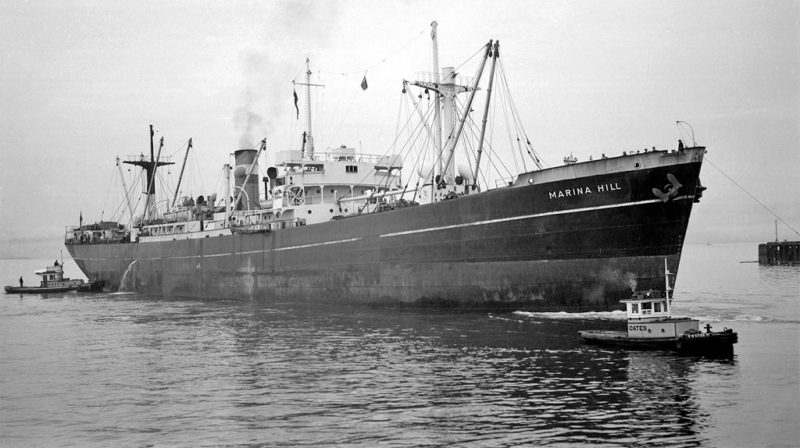
The steering gear was checked and found to be in order but it was eight hours before the gale moderated and Marina Hill could resume course for Newport News, which was reached four days later. Sixteen ‘Forts’ and ‘Parks’ were owned by the company in 1960, gradually reducing by sales to fourteen in 1962, ten in 1966, with the final few being sold for breaking up in 1967/68 after 25 years of service.
In 1948, Basil Mavroleon was tasked with setting up a tanker arm for the partners, which he did on 8th April 1948 with a capital of £100 as London & Overseas Freighters Ltd. (LOF). Basil Mavroleon was Chairman and Managing Director, with Manuel Kulukundis and his brothers John and George as directors. Office space was hard to come by in London at this time, and a badly damaged building in Balfour Place in Mayfair was rebuilt to house new staff including Stanley Sedgwick, a 34 year old accountant, who began long service with the company on 1st January 1949 as Company Secretary.
The first tanker owned by LOF was the former Shell tanker Cardium of 8,236 grt which was renamed Haverton Hill under Counties management before transfer to the new company once it was established. She had been built at Wallsend in 1931 by Swan, Hunter & Wigham Richardson Ltd., but was sold after three years to Liberian owners and renamed Don Manuel, being broken up at Vigo in 1961 after being damaged by an engine room fire off Dakar on 13th August 1961.
Nine war built dry cargo ships owned by the Putney Steamship Co. Ltd., Dorset Steamship Co. Ltd. and the Tower Steamship Co. Ltd. were at first transferred to the new LOF company until the first tankers were completed as London Pride and London Enterprise of 16,345 dwt in 1950 by the Furness yard on Teesside. This pair and three more tankers of this size from the Furness yard were taken on five year charters by Shell, and their orders had required an ‘up front’ payment of £5 million before work could begin. The shares in three steamship companies were exchanged for 1.7 million shares in LOF and the three companies were then wound up. LOF was the first London Greek company to achieve a listing on the London Stock Exchange in 1951, to the great credit of Basil Mavroleon, the second London Greek company achieved this thirty years later in 1981.
A big total of fifty tankers, dry cargo ships and bulk carriers with names carrying a prefix of ‘Mayfair’, ‘London’ or ‘Overseas’ were then traded over the next fifty years until 1998 when the last charter was completed, an agreement having been signed on 22nd September 1997 to merge London & Overseas Tankers Ltd. (LOT formed in 1956 in Hamilton, Bermuda) with Frontline Tankers A/B of Sweden with offices in Hamilton in Bermuda and owned by John Fredriksen.
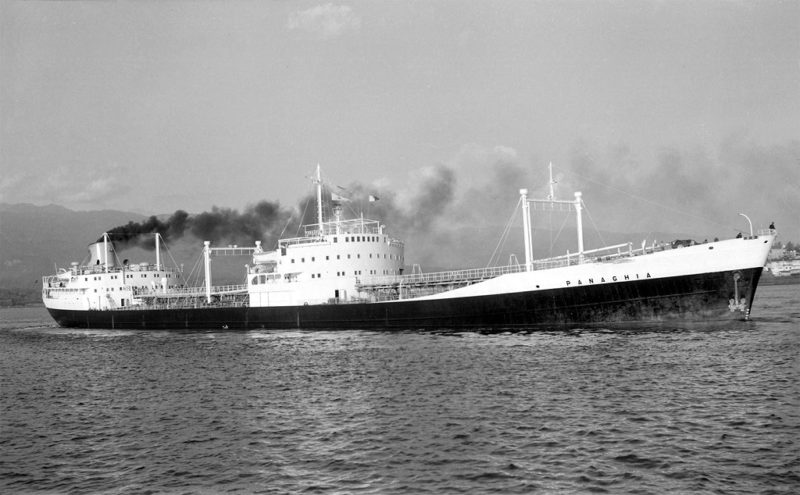
Rethymnis & Kulukundis Ltd. and Mavroleon Brothers Ltd. shared the same London offices at St. Clare House at 30-33 Minories, and were to build up a large fleet of Greek, Liberian and Panamanian registered ships owned in Greece in post-war years. The Greek owned fleet of R & K was rebuilt with:-
Dry cargo ships such as Aghia Marina of 12,670 dwt, launched on 22nd March 1954 by Nitsa Matantos (nee Pneumaticos) at the Doxford yard, and Aghios Nicolaos of 11,120 dwt in 1955 and Aghios Spyridon of 14,560 dwt also completed in 1957 by the same yard at Sunderland. A further five dry cargo ships were built in Holland and Japan.
Tankers such as Altair of 16,325 dwt (ex London Enterprise), Andromeda of 18,450 dwt in 1957, Antares of 18,500 dwt in 1957, Aries of 18,500 dwt in 1957, Arcturus of 28,328 dwt in 1953, Proteus of 25,200 dwt in 1955, Sirius of 24.900 dwt in 1955, Perseus of 24,830 dwt in 1956, Taurus of 32,500 dwt in 1956, and Vega of 33,000 dwt in 1958. Five more tankers of Cygnus of 16,260 dwt, Vassiliki of 16,160 dwt, Panaghia of 24,940 dwt, Virginia of 18,800 dwt, and of 18,800 dwt were built during 1955/58 by the Furness yard on Teesside.
The Cardiff tramp Llanwern of 13,460 dwt, completed by the Bartram yard in 1962, was purchased in 1968 and renamed Captain Michael, and the bulk carrier Pacific Princess of 24,800 dwt built at Blyth in 1964 was later purchased and renamed Canopus. A dry cargo ship of 14,140 dwt was completed in 1961 named Pollux, and had been built by A. Vuyk & Zonen in Holland with a service speed of 15 knots from a Sulzer diesel engine. Capetan Elias and Capetan Stathes were the new names of tankers of 26,000 dwt built in 1957/58 at Belfast and Kiel when later purchased.
These R & K London Greek companies were managing over forty ships in 1973 from their big St. Clare House office in the Minories in London. These included tankers of up to 36,800 dwt, the ore carriers Finnamore Meadow of 18,420 dwt built by Austin & Pickersgill Ltd. in 1961, and Victore of 27,894 dwt from the same yard in 1963, and Nitsa of 27,870 dwt launched on 19th November 1970 in Sweden by the Oresundsvarvet yard, and Oread of 31,490 dwt built in 1956 by Nippon Kokan.
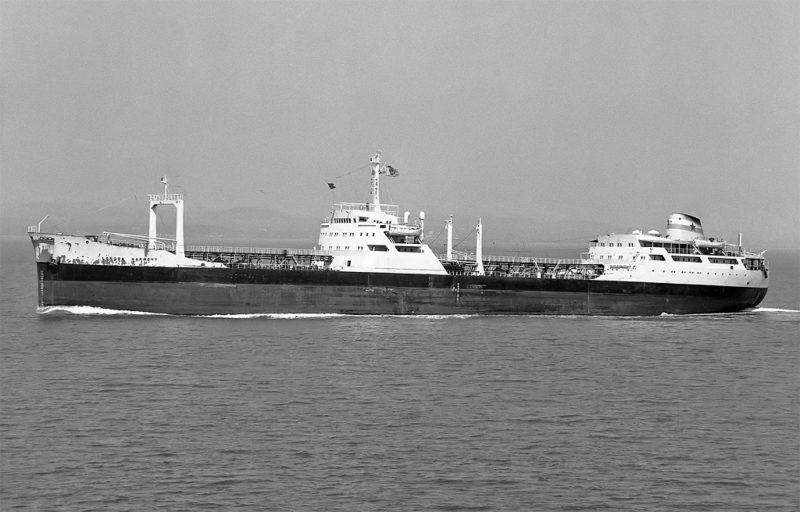
The five hold engines ‘midships Finnamore Valley of 7,357 grt was completed in 1961 by the De Schelde yard at Flushing for Mavroleon Brothers to a standard Dutch design with two sisters completed for LOF. She and Finnamore Meadow had a red ‘M’ on their funnels instead of a red star for ‘Counties’ on the blue and white bands. Finnamore Valley was sold in 1971 to Sri Lankan owners and renamed Lanka Rani and was broken up in 1986 at Malpe in India.
Several SD14s were built to their very successful design by Austin & Pickersgill Ltd. for management by the partners, the Sunderland yard having been purchased by a consortium of three companies including LOF in 1957, with LOF then buying out its two partners in 1970 to take full ownership. Bulk carriers such as Vasilios R of 16,200 dwt in 1962, Alessandra of 26,340 dwt in 1967, Helene and her sister County Clare of 26,185 dwt in 1970 and later ‘B35’ bulk carriers of 35,000 dwt were built by this famous yard for management by the partners.
The Doxford & Sunderland Shipbuilding Group built the dry cargo ship Marigo R. of 16,480 dwt in 1969 for management by the partners. Tankers of up to 31,000 dwt were purchased for charter to Permina Oil, and up to 20,000 dwt for charter to Stolt Tankers. In 1969, a 50% stake in Welsh Ore Carriers Ltd. was acquied, taking over the ore carrier Welsh Herald of 27,680 dwt built by Austin & Pickersgill Ltd. in 1963, the ore carrier Welsh Minstrel of 31,100 dwt built at Rijeka in 1968, and three SD14s in Welsh Endeavour, Welsh Trident and Welsh Troubadour.
However, the oil crisis of 1973 badly hit the London Greek partners with many of their big fleet no longer economically viable and laid up at Perama near Piraeus until they were later sold for breaking up. The R & K owned and managed fleet became smaller as freight rates fluctuated wildly during the next decade before picking up again in the late 1980s. Austin & Pickersgill Ltd. built the bulkers Anna M and Camilla M of 26,700 dwt in 1976 for Mavroleon Brothers, and they were renamed in 1979 as Vitina and Kasos respectively, with both sold off in 1986 and Anna M broken up under the name of Angel in May 2006 and Camilla M broken up at Shenzhen in China in March 2003 as Nicholas Trader. The bulker Golden Swan of 28,900 dwt was purchased in the same year of 1979 and renamed Vasilis. A new bulker of 29,000 dwt was completed during 1981 as Violetta (2) by the Hakodate Dock Co. Ltd. at Muroran in Japan.
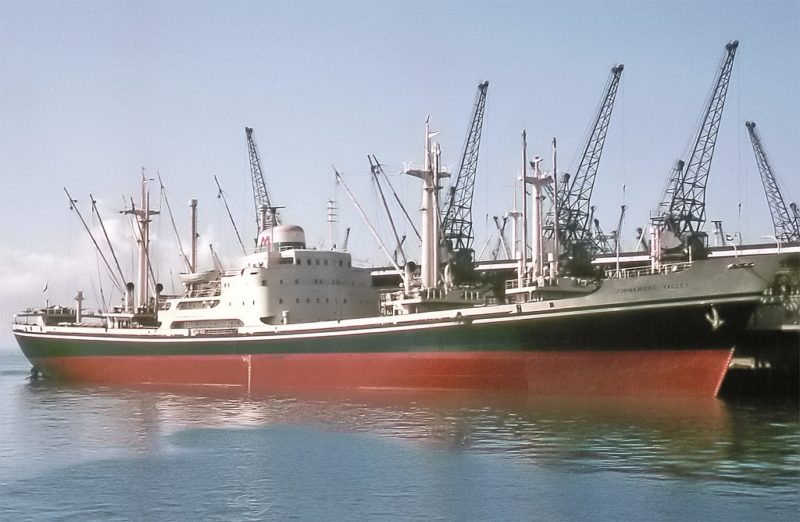
The bulk carriers of the Star Consortium pool of Greig Shipping A/S of Norway included several chartered in by R & K to the pool during the period from the 1980s to the 1990s, including Star Lily and Star Castor of 27,000 dwt built in 1973:-
- Star Lily (2) of 34,300 dwt built in 1977
- Star Antares of 42,000 dwt built in 1984
- Star Canopus of 42,950 dwt built in 1985 Star Castor (2) of 34,600 dwt built in 1984 Star Centaurus of 42,650 dwt built in 1985 Star Dragon of 34,214 dwt built in 1977
- Star Jasmine of 34,290 dwt built in 1978
- Star Michalis of 37,575 dwt built in 1985
- Star Libra of 42,650 dwt built in 1985
- Star Nitsa of 39,900 dwt built in 1983
- Star Orchid of 34,600 dwt built in 1984
- Star Polaris of 43,775 dwt built in 1996
- Star Pollux of 43,769 dwt built in 1996 and Star Sirius of 38,100 dwt built in 1985
This fleet voyaged mainly around the Pacific Rim areas carrying the usual variety of bulk cargoes.
The founder Manuel Kulukundis died in July 1988 just weeks short of his 90th birthday, with his brother Capt. Nicholas Kulukundis dying in America in December of that year. The young Minas Kulukundis was to attend the funeral of Capt. Nicholas Kulukundis, but became a victim of terrorist activity when his flight PAN AM 103 was downed on 21st December 1988 by a bomb over Lockerbie in Scotland.
Capt. Nicholas B. Rethymnis, a founder of R & K in 1921 and elder brother of Minas Rethymnis, had died earlier in that decade on 9th October 1981, having run the New York office in Broad Street of the Rethymnis Steamship Agency Inc. since World War II. He had also built and owned an historic repair yard on Syros, which was later expanded by John Goulandris into the Neorion Shipyards Syros Ltd., with two big floating docks of 11,000 and 25,000 tonne lifting capacities, and facilities for repairing large ships afloat.
Product tankers were being traded again at this time as tanker freight rates had improved, and included the newbuildings Pegasus of 37,182 dwt built in 1981 and Andromeda of 63,531 dwt in 1984 from the Hitachi Zosen yard in Japan and powered by a seven cylinder B & W oil engine of 12,800 bhp to give a service speed of 15 knots. The tanker Procyon of 56,050 dwt was purchased in 1990 and renamed Nova Europa and had been built in 1975 as Cyclops for Blue Funnel Line.
The Head Office of Rethymnis & Kulukundis Ltd. in 1998 was in New Fetter Lane in London with an affiliated company of the Pegasus Maritime Enterprises Inc. in Athens. The R & K fleet were making the following voyages in November 2000, mostly around the Pacific Rim areas:-
Star Antares – Dunkirk to Bang Saphan Yai (Thailand) and Kuantan (Malaysia)
Star Canopus – Fremantle to Esperance (Australia)
Star Castor – Townsville to Nantong (China)
Star Libra – Bluff (New Zealand) to Hay Point (Australia)
Star Michalis – Townsville to Amamapare (Papua New Guinea)
Star Polaris – Jeddah to Richards Bay (South Africa)
Star Pollux – Richards Bay (South Africa) to Manaus
Star Sirius – Townsville to Singapore and Dahej (Gulf of Khambhat in India)
However, the remaining R & K partners had sold up and moved back to Greece in 2003, disposing of all of their office records and ship models. The Canopus Shipping Ltd. and three bulkers Star Canopus, Star Polaris and Star Pollux were then managed from Greece. Star Polaris continued trading until she was sold off in 2011 e.g. she was loading at Vitoria in Brazil in April 2008.
The company name of R & K in London has been continued by London Greek shipowners related to the R & K families and is currently trading in 2021 with two sister Supramax bulkers of 58,518 dwt named Astra Centaurus and Astra Perseus, delivered in August and September 2012 by the Daewoo Shipbuilding & Marine Engineering (DSME) yard at Yantai in China. They are geared bulkers equipped with four deck cranes of 30 tonnes capacity for worldwide trading, and have a ballast water treatment system, and burn distillate fuels to cut air pollution. They are operated by Pegasus Maritime Enterprises Inc. of Athens, who also manage a fleet of bulk carriers of varying sizes. They wear the same R & K yellow funnel colours of the Counties Ship Management Co. Ltd. that were adopted for the post-war fleet in 1946. The original R & K funnel colours in the inter-war years were black or yellow with the same white and blue bands superimposed by a red star.
It is very pleasing for ship enthusiasts to know that the very famous funnel colours are still seen around the world today. Astra Centaurus was loading at Tianjin in China in November 2014, and at Antwerp in September 2020, while Astra Perseus was loading at Quebec in December 2012 and at Gargoub, a new port in Western Egypt, 75 kilometres west of Marsa Matrouh in September 2020, both are registered at Majuro in the Marshall Islands in the Pacific.
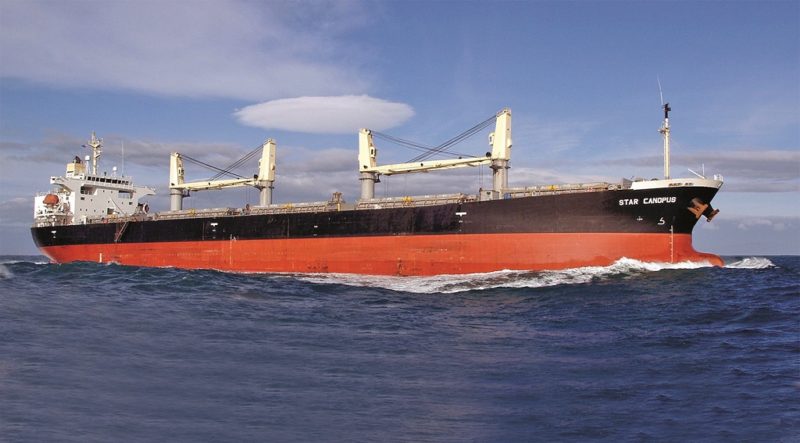
POSTSCRIPT
There have been well over one hundred London shipping offices representing Greek shipowners during the last one hundred years, but R & K were by far the most successful of the families that were permanently residing in London. The five storey Balfour Place in Mayfair building used by London & Overseas Tankers (LOT) as offices on the ground floor by the directors and staff, with apartments on the upper floors for the directors, was sold off in 1997 to developers and turned into luxury apartments and boutiques in a development worth around £100 million.
I have written at length or in short summaries about many Greek shipowners including Andreadis, Apodiakos, Carras, Chandris, Colocotronis, Chronos, Coulouthros, Goulandris, Hadjioaanou, Hadjilias, Karageorgis, Livanos, Lemos, Latsis, Lykiardopulos, Marchessini, Mavrakakis, Michalinos, Michalos, Niarchos, Nomikos, Nicolaou, Onassis, Papadakis, Papachristidis, Polemis, Thenamaris, Theodoracopoulos, Tsakos, and Vergottis, and others including the Eletson Corporation with a big fleet of tankers.
However, none of these seemed as familiar and well known to me as the R & K families, due to their ownership of the Austin & Pickersgill Ltd. yard at Southwick in Sunderland, where I worked on the introduction of computerised production control systems.

There were Greek Shipping Directories available at the yard, and the Managing Director Derek Kimber, who died in December 1995, was also Managing Director of London & Overseas Tankers Ltd., part of the big R & K shipping empire. The centenary date of R & K on 21st July 2021 was a cause for great celebration due to their longevity.
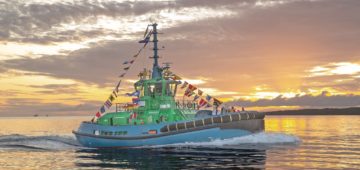


Comments
Sorry, comments are closed for this item